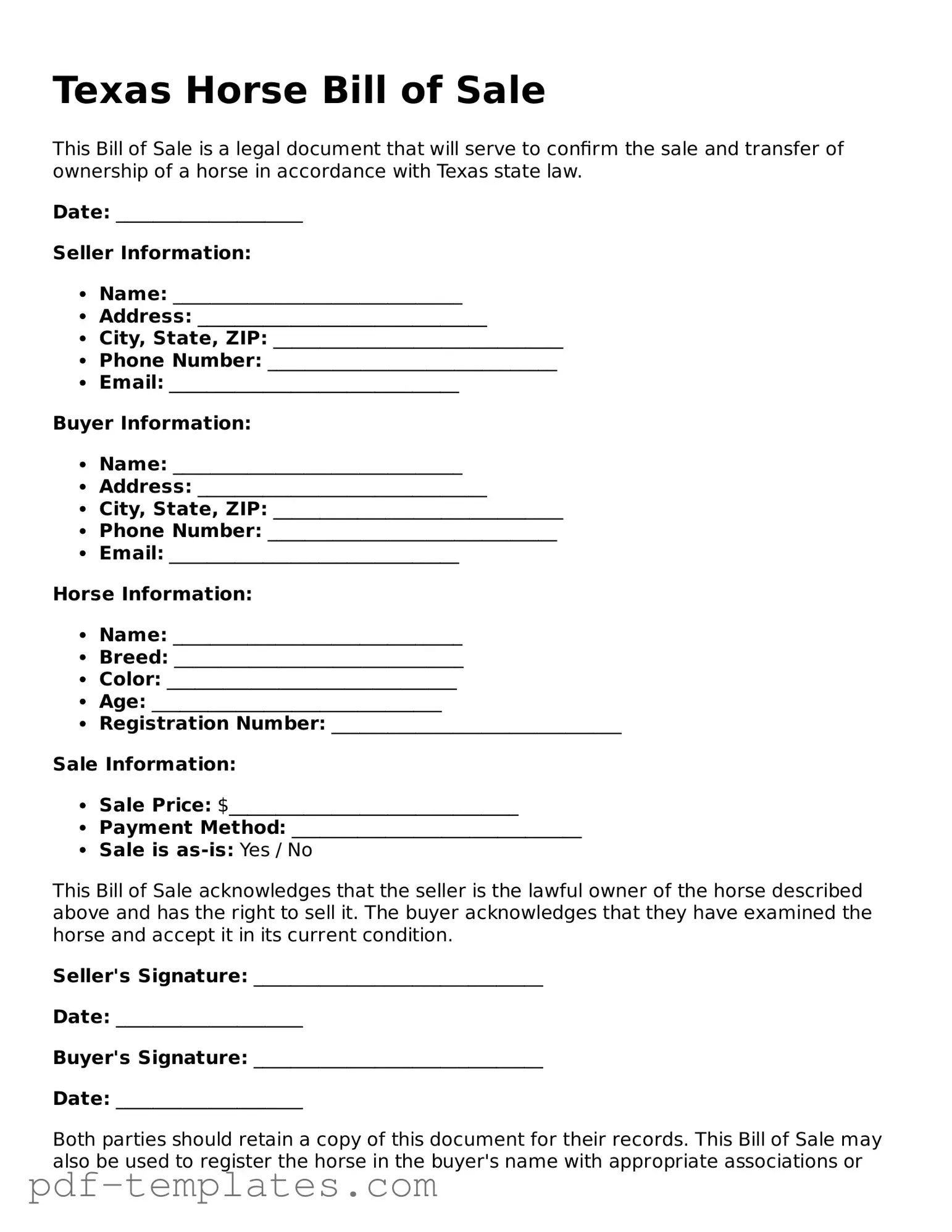The Texas Horse Bill of Sale form is similar to the general Bill of Sale, which is used for various types of personal property transactions. Just like the horse-specific version, this document serves as proof of transfer of ownership from one party to another. It typically includes details such as the buyer's and seller's names, a description of the item being sold, and the sale price. Both documents protect the interests of both parties by providing a clear record of the transaction.
Another similar document is the Vehicle Bill of Sale. This form is used when buying or selling a car, truck, or motorcycle. It includes information about the vehicle, such as the make, model, year, and Vehicle Identification Number (VIN). Like the Horse Bill of Sale, it verifies the transfer of ownership and can be important for registration and title purposes. Both documents help prevent disputes by documenting the sale terms clearly.
The Boat Bill of Sale also shares similarities with the Horse Bill of Sale. This form is utilized when a boat is sold, detailing the specifics of the vessel, including its make, model, and hull identification number. Just as with the Horse Bill of Sale, it serves as proof of ownership transfer and may be required for registration with state authorities. Both documents provide essential information to ensure a smooth transaction.
The Livestock Bill of Sale is closely related to the Horse Bill of Sale, as it specifically deals with the sale of livestock, including cattle and sheep. This document outlines the details of the animals being sold, including their identification and health status. Both forms serve the same purpose of confirming ownership transfer and protecting the interests of the buyer and seller in livestock transactions.
For those interested in legal documentation, a comprehensive understanding of the Power of Attorney for a Child is crucial. This essential form allows caregivers to make important decisions on behalf of their child in times of need. To learn more, visit this resource on the Power of Attorney for a Child document.
The Pet Bill of Sale is another document that shares similarities with the Horse Bill of Sale. This form is used when pets, such as dogs or cats, are sold or adopted. It includes details about the pet, such as breed, age, and any health records. Like the Horse Bill of Sale, it provides proof of ownership transfer and can help clarify any agreements regarding the pet's care or responsibilities post-sale.
The Equipment Bill of Sale is used for the sale of various types of equipment, such as farm or construction machinery. This document outlines the specifics of the equipment, including its condition and any warranties. Similar to the Horse Bill of Sale, it serves as a legal record of the transaction, ensuring both parties have a clear understanding of the sale terms and protecting against future disputes.
The RV Bill of Sale is used for the sale of recreational vehicles. This document includes detailed information about the RV, such as its make, model, year, and VIN. Like the Horse Bill of Sale, it confirms the transfer of ownership and may be necessary for registration and titling purposes. Both documents help ensure that the buyer is aware of what they are purchasing.
The Mobile Home Bill of Sale is another related document, specifically for the sale of mobile homes. It includes details about the home, such as its size, model, and serial number. Similar to the Horse Bill of Sale, it acts as proof of ownership transfer and may be required for local registration. Both documents ensure that the transaction is documented and legally binding.
Finally, the Business Bill of Sale is used when selling a business or its assets. This document outlines the terms of the sale, including the assets being transferred and any liabilities. Like the Horse Bill of Sale, it serves to protect both parties by clearly defining the terms of the transaction. It ensures that the buyer knows what they are acquiring and that the seller has proof of the sale.
